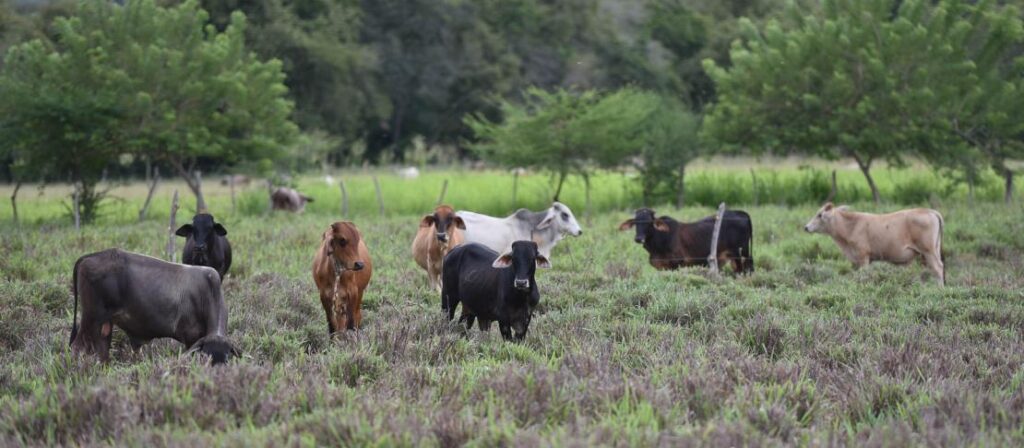
A new journal article analyzes the emission reduction practices of the livestock sector in seven Latin American countries and their potential to contribute to the fulfillment of the Paris Agreement goals.
CALI, COLOMBIA – Despite the importance of the livestock sector for the economies of different Latin American countries, livestock is one of the largest sources of greenhouse gas (GHG) emissions in the region. According to a recent study, the agricultural sector in Latin America produces 20% of the region’s GHG emissions, 70% of which come from livestock. A transformation in livestock production is necessary if countries are to meet the emission reduction goals in their Nationally Determined Contributions (NDCs) under the Paris Agreement and achieve the Sustainable Development Goals (SDGs).
An analysis of how this transformation can be achieved is the objective of a new journal article in the journal Frontiers “Ambition meets reality: achieving GHG emission reduction targets in the livestock sector of Latin America“, by researchers from the CGIAR Research Program on Climate Change, Agriculture and Food Security (CCAFS), the Alliance of Bioversity International and the International Center for Tropical Agriculture (the Alliance) and a group of experts from different agricultural research institutions in Latin America.
The NDCs of Colombia, Brazil, Argentina, Costa Rica, Uruguay, Mexico and Peru were analyzed to find out what the countries’ goals for reducing GHG emissions are, then these goals were contrasted with the technologies and practices reported to achieve such reduction over a defined period of time. According to the findings, a redefinition of NDCs may be necessary, since researchers identified that the countries could not meet their goals in reality.
The researchers found that—while a range of practices have been increasingly adopted including silvopastoral systems, dietary changes, improved forage quality, improved pasture management, and improvement of reproductive efficiency, among others—the adoption of these practices by livestock stakeholders remains limited.
Solutions exist, but barriers to adoption remain
Latin American countries must define more ambitious goals for GHG emissions reductions, which are necessary to achieve the 1.5°C warming limit defined in the Paris Agreement. These goals should also be raised within the livestock sector to increase the scaling and adoption of practices to reduce emissions.
To achieve this, producers must have access to inputs, capital and information, as identified in the study. “The first can be achieved through the development of formal systems of replication of grass and legume seeds. In Latin America this strategy is still underdeveloped,” explains Alejandro Ruden, an author of the article, and Research Associate at the Alliance.
For researchers, a formal, subsidized credit system is essential to scale different practices and technologies. These credits can be granted to small and medium producers through mechanisms such as differentiated pricing for products from environmentally friendly systems or through payments for ecosystem services.
“Access to information can be achieved through efficient dissemination channels, as well as through the strengthening of effective and unified technical assistance and outreach systems,” Ruden argues.
Articulate actions among the livestock sector to raise ambition
Ensuring that information generated in scientific and academic circles gets to producers is key to enabling the livestock sector to implement practices to reduce emissions and make their production processes more sustainable.
“It requires the genuine commitment of decision makers at the ministerial level, to put into action in an articulated and efficient way the GHG mitigation strategies, product of scientific research in Latin America,” says Dr. Juan Ku-Vera, researcher at the Autonomous University of Yucatan, and co-author of the study.
Sustainable livestock production will contribute to the achievement of SDGs (i) Zero Hunger (SDG 2); (ii) Climate Action (SDG 13), and (iii) Life On Land (SDG 15), if national policies are aligned to improve productivity while reducing emissions intensity.
“It is necessary that the academic, research, business and public policy sectors can support and encourage the changes needed to raise the level of ambition and achieve the SDGs, considering actions from the farm to national scale,” concludes Jacobo Arango, one of the authors of the study and leader of CCAFS’ LivestockPlus II research project.
For more information, please contact Lauren Sarruf Romero, Communications Officer for CCAFS Latin America (l.sarruf@cgiar.org).
For interviews and other inquiries, please contact Jacobo Arango, leader of CCAFS’ LivestockPlus II (j.arango@cgiar.org).
Funding and partners
The CGIAR Research Program on Climate Change, Agriculture and Food Security (CCAFS) contributed funding to this project, which is carried out with support from CGIAR Fund Donors and through bilateral funding agreements. For details, please visit https://ccafs.cgiar.org/donors.
